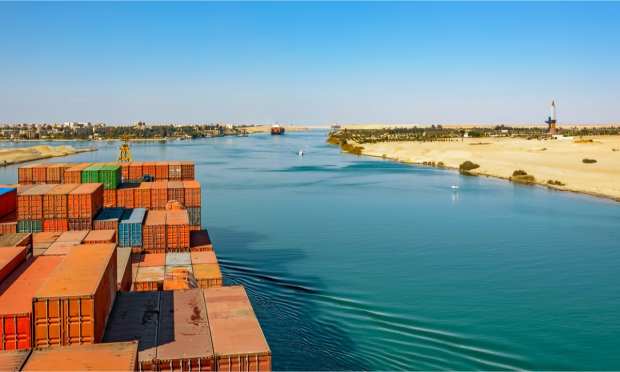Connected Economy Stuck In The Suez

As if the supply chain disruptions brought about by the global pandemic last year weren’t enough to point out just how connected the connected economy really is, earlier this week a 1,300-foot-long container ship wedged itself in the Suez Canal, effectively pushing the pause button on the movement of goods through the critical waterway. Now, there are almost 200 ships holding goods ranging from oil to textiles waiting behind the Ever Given while Egyptian engineers figure out how to unstick the massive 200,000-ton barge.
“When she lost control, she literally rammed her bow into Asia and she’s put her stern ashore on Africa,” Campbell University history professor Sal Mercogliano told CNBC’s Shephard Smith Thursday (March 25) in an interview. “And she’s astride one of the narrowest parts of the canal.”
By blocking the pathway between the Mediterranean and the Red Sea, the wedged ship has effectively stopped the flow of about 50 vessels that move nearly $10 billion worth of goods every single day. The Ever Given itself is one of the largest container vessels on the seas, capable of holding 20,000 metal shipping boxes, says The New York Times. While there are almost 200 vessels bobbing in the waters both in front of and behind the Ever Given, an analysis by Bloomberg shows a total of about 300 ships globally affected by the blockage.
According to the AP, traffic through the Suez Canal accounts for about 10 percent of all global trade. When the canal was opened in 1869, it allowed ships to shave 3,500 miles off the trip around Africa’s southern tip, creating a faster, cheaper way to move goods between Asia and Europe. While some ships are being rerouted around Africa — including those by the Ever Given’s owners, Taiwan-based Evergreen Marine — others are simply waiting in line to continue on their journeys.
Those ships hold products critical to global productivity, including things like cotton from India for textiles and auto parts from China, AP reports. It’s also a major passageway for the transportation of oil. According to Bloomberg, of the ships waiting in line, 17 are crude oil tankers, while 35 are container ships like the Ever Given and 40 are bulk carriers.
Pivotal Node
“The fact that you have the most pivotal node in the trading network being blocked is going to have important welfare effects around the world,” Woan Foong Wong, an economics professor at the University of Oregon told the AP’s David Koenig and Chris Rugaber.
While the blockage will certainly have an impact on the global availability of goods, The New York Times reports that one of the other major ripple effects the stuck ship will cause is that the containers it holds, along with those on the other ships affected, will now be taken out of an already thinning supply.
Shipping containers themselves started to run low as the pandemic upped the American demand for goods such as exercise equipment, new TVs and cookware during lockdowns. The shortage of dock workers due to COVID-19 infections and lockdowns also meant many containers sat on ships unopened longer than usual. This caused the cost of a shipping container from Asia to North America to nearly double, according to the Times.
This latest snafu is bound only to increase those prices, with the paper reporting that as much as a quarter of all containers usually docked at European ports will be stranded. Additionally, once the Ever Given is finally unstuck, the pressure on ports will mount with ships arriving all at once to offload their goods. Plus, should shipping companies decide to reroute deliveries around Africa instead of through the canal, fuel costs will skyrocket and no doubt get passed on to consumers.
Just In Time
Much in the same way the pandemic did, the Ever Givens crisis points out an issue with what’s known as “just-in-time” manufacturing, says The New York Times. This policy saw a shift from manufacturers making and storing goods in warehouses to simply producing them on an as-needed basis. While such a policy ups profits by letting companies move warehouse expenses off their ledgers, it clearly is subject to vulnerabilities such as not having enough masks, hand sanitizer or respirators on hand when a global pandemic strikes.
“As we become more interdependent, we are even more subject to the fragilities that arise, and they are always unpredictable,” Ian Goldin, a professor of globalization at Oxford University, told the Times. “No one could predict a ship going aground in the middle of the canal, just like no one predicted where the pandemic would come from. Just like we can’t predict the next cyberattack, or the next financial crisis, but we know it’s going to happen.”
Get Moving?
So when will the 200,000-ton ship get unstuck so that commerce can once again flow normally? Bloomberg reports Friday (March 26) that it is not expected to move until at least Wednesday.
“The delays are likely to increase costs, adding to already widespread inflationary pressure on supply chains,” Chris Rogers, lead trade analyst for S&P Global Market Intelligence’s Panjiva, told Bloomberg. “The short-term ripple effects will be an increased potential for stock-outs in consumer goods and the risk that just-in-time manufacturing supply chains that had already been roiled by Brexit and commodity shortages may face further interruptions.”
